The Ultimate Guide for Couples Moving in Together
You and your partner have decided to take the leap and move in together. By now, you’ve probably realized that there’s a lot more to it than just moving your stuff to a new place – like finding new digs, sorting through your stuff to decide what stays and what goes, talking about money and how much rent you both can afford, and getting mentally prepared to share a space with each other 24/7. Because we’ve been there, Moveline has put together this handy guide for couples moving in together for the first time with practical tips and advice to make your move a little easier and less stressful.
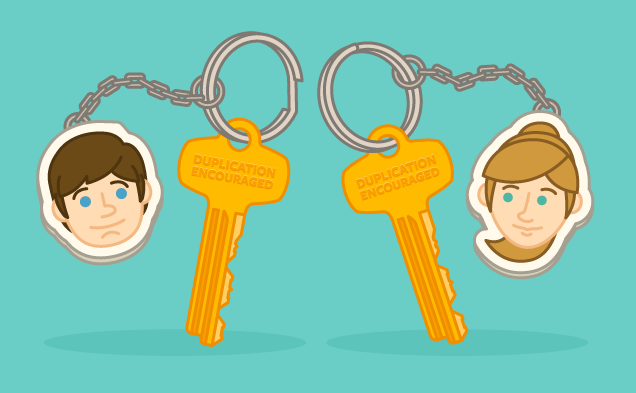
The Perks of Moving in Together
Okay, so moving in with your sweetheart may take a fair amount of planning, coordination, stress and money. But let’s first look at the upside of moving in together and why it can be the perfect solution for some couples.
Aaron and Anna, both 29, met at a party in New York City and had dated only a few months before Anna moved to Madison to begin her PhD at the University of Wisconsin. The couple continued dating long distance for a year, seeing each other once a month. Then Aaron enrolled in the university’s MBA program and moved in with Anna.
Being able to see each other every day is great,” says Aaron. “Anna is a really great cook, so I no longer eat a sandwich over the sink as most single guys do. We’re both graduate students, so it’s nice to be able to support each other when we have tough weeks.

“There’s a lot to do in Madison that’s very couple-based,” says Anna. She says the campus is situated between two lakes and there are great bike paths in the area to explore.
Brian and his girlfriend Hannah, both 26, began dating at Purdue University before Brian graduated and moved to Chicago, over two hours away. Now that they live together in Blacksburg, Virginia, they can enjoy home life and their mutual hobbies.
“We both like the same TV shows and movies. We both have a passion for travel. We like to play sports, so we play on the same indoor soccer team and volleyball team. We go running together and play tennis together. Saving gas money is also nice,” says Brian.
Sara, 26, and Brad, 27, once lived on opposite sides of Chicago, so planning evenings together and coordinating their busy schedules was a hassle. The couple also found they were maintaining two apartments – cleaning, paying bills and buying food – and decided it was time to move into one place. Now, she cooks, he goes grocery shopping, and they’re able to share everyday moments that come with living together.
“Now we have time to do yoga every Saturday,” says Sara. “We get to spend time together that’s actually quality. Before we were coordinating travel and packing bags. Now we can watch a movie and hang out in a way we weren’t able to before.”
There are a lot of great reasons to move in with your significant other. Some are emotional – you want to spend more time together and support one another. There are also many financial benefits – shared rent and groceries and getting rid of the time and expense of commuting to see each other. If you’ve decided that now’s the time to take the leap, you’ll first want to consider a few important matters before, during, and after your home search to ensure the transition from separate dwellings to one happy home is as smooth as possible.

Before You Search for a New Place
Before you start cruising rental apartment ads on Craigslist, there are some steps that could save you some time, money and stress before the move.
Step 1: Take a good look at all of your stuff
So much about moving is about the stuff in our lives. Most likely you’ll find things that are duplicates between your two apartments – two spatulas, two coffee tables – or things that you don’t want anymore. Then there’s the big stuff, like dressers and sofas that may not fit in the new place. Now’s the time to look at the stuff in both of your apartments and figure out what you have, what you’re keeping, and what you’re selling, donating or tossing before the move.
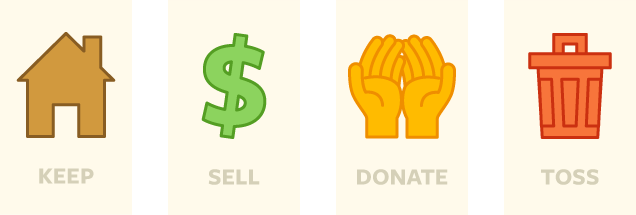
If you’re feeling tempted to put this off until after the move or skip it altogether – don’t. That could be the most costly mistake you make. Why? Because everything you keep adds to the cost of the move – whether that’s in dollars or in the time it’ll take to move everything and the physical strain on your body (more on that later). Plus, all that stuff is going to need to fit into the new place. Imagine what it’s going to be like when all the boxes are there. Will there be room to put them away until you can sort through it? Will keeping everything force you to rent a larger apartment than you can really afford?
David Schorr, a sales executive in Manhattan, says that when his girlfriend, now his fiancé, moved in with him fours years ago, neither one downsized their belongings beforehand, which led to their shared space feeling chaotic and cramped.
“It was essentially her stuff on top of my stuff,” says David. “In reality, I should have done a massive purge before she moved in and she should have done the same. It’s really important to make sure that the stuff you have combined is going to fit comfortably in the place you’re going to move into.”
So before you even begin looking at apartments, first get a realistic idea of how much space you need by figuring out how much stuff you’ll have after you’ve decided what you’ll keep and what you’ll sell, toss or donate.
Pre-Move Checklist
- Take an inventory of both apartments
- Decide together what you’ll keep, sell, toss or donate
- Measure everything that’s left (furniture, etc.)
- Decide how much square footage you need
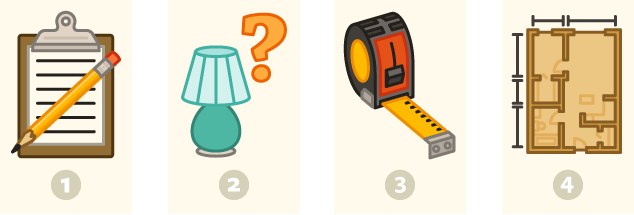
Step 2: Your place, their place or a new place?
The next question is: will you move into their place, stay in yours or find a new place together? This might be an easy decision if you both live in studio apartments and what you really need is a two-bedroom. If however, one person already lives in a two-bedroom, you’ll still need to take into consideration other factors like commutes to work, accommodations for any pets, neighborhood amenities like parks, restaurants and shopping, and safety. Talk about your must-haves. If either of your places doesn’t make the cut, start brainstorming a short list of locations to start your search.
Sometimes the decision whether to go or stay might have less to do with the actual apartment and more to do with achieving a shared sense of ownership and starting a new chapter in the relationship. Johanna, 30, was living in a one-bedroom apartment in Manhattan when she and her boyfriend decided to move in together. Even though he already had a two-bedroom apartment in the city, they wanted to start fresh and rented a new two-bedroom that ended up costing about the same as renting separately.
“Neither wanted to feel like they were joining an established life,” she says. “We wanted to start from the beginning together in a place that was new to both of us.”
David adds that starting fresh not only gives couples more freedom to choose square footage that works for all of their stuff, but also provides a clean slate to create a uniform interior design with a consistent look and feel both people agree on.
Step 3: Decide together what you’ll keep, toss or donate
Remember, everything you keep adds to the cost of your move and the amount of square footage you’ll need in the new space. If you’re hiring movers, the price you’ll be quoted will be based on weight, so the heavier the load, the more expensive it’ll be to move. Now is the time to ask yourself if that huge desk you found at a garage sale is really worth the extra cost to keep it.
For Johanna, moving in with her boyfriend meant getting rid of a few pieces of large furniture, like her dresser, because their new place has more closet space than her current apartment.
“Paying someone to move it was the biggest motivator,” she says. “I know the person who’s moving into my apartment so I already pre-sold a lot of my extra stuff to him, which is really cool.”
If you’re considering trying to sell used items, start the process as early as possible to increase the chances it’ll get sold before moving day. Johanna listed her dresser on Craigslist for $40, but days before the move it still hadn’t sold. If it doesn’t she’s considering asking her movers, who also sell used furniture, to take it off her hands.
“At that point, my desperation of getting this thing away from me will override the money. It would be nice for someone to buy it, but I have so many other things that I’m overwhelmed with that I’m not going to make a big deal of it.”
Avoid delaying your decision to get rid of items just to see whether it might fit in the new apartment. It’s a waste of money to pay movers to move stuff you ultimately won’t keep. It’s easier and much cheaper to take measurements, consider the square footage and plan accordingly. Letting go of stuff can be painful, but it can also be liberating. Think of it as making room for a new life with your partner.
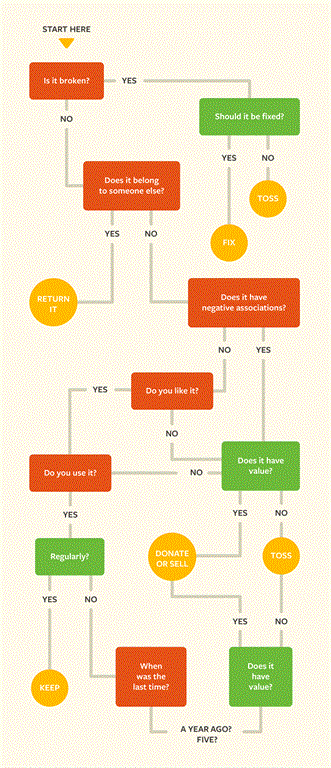
Tip: Resolving keep/toss conflicts with your partner
For some, the pre-move purge might seem like the perfect opportunity to get rid of their partner’s ugly or seemingly useless stuff. The old VHS collection he’s had since junior high? Out of here. The stacks of books she’s been holding on to for years? Gone. But wait. Here’s a tip: if you really want to get rid of this stuff, you’ll have more success if you use gentle suggestions and open communication. Some things your partner might be more than willing to give up, but others not so much.
When Johanna and her boyfriend decided to lease their new apartment, Johanna’s mother, an interior designer, drew up a floor plan to help the couple decide the best placement for their furniture. Unfortunately, the large metal shelf containing her boyfriend’s boxes of electronic parts didn’t fit the plan.
“When I confirmed that the measurements don’t work out, he bristled a little bit,” says Johanna. “I think he thinks I’m trying to get rid of all of his stuff, which is not the case. I just want to figure out a place where the boxes can be out of sight but still accessible. I probably haven’t been communicating that part well.”
Aaron says couples moving in together should try to be sensitive to the other person’s emotional attachment to their stuff. The mountain of books Anna had accumulated as an English undergraduate and now a composition and rhetoric graduate student once covered the floor of their apartment, prompting Aaron to suggest she get rid of half of them. Anna balked at the suggestion.
“My thinking was that I they were all I own. The only things I actually really own are books and clothes,” laughs Anna.
Aaron admits that his first approach was compulsive and didn’t factor in Anna’s feelings about her books. “It’s easy to say, ‘We don’t need two of these. We can downsize that. I don’t know what we need all this stuff for’ – thinking of ways to get rid of things before you realize that they’re meaningful objects to the other person.”
Also adding to the space problem in their apartment was Aaron’s framed art pieces. The couple solved the problem by renting a storage space. Since they live in a loft with high ceilings, they took advantage of the vertical space with shelves Aaron built to house the books and artwork. The result is an impressive, custom-built wall unit that shows off the height of the room and displays their books and artwork.
“It was a relief knowing there was an elegant solution to storing them. It looks pretty cool and I used a lot raw wood and industrial brackets that work with our loft space,” says Aaron.
Sara and Brad found that by getting creative with storage they too were able to keep more of their stuff. Sara didn’t like that Brad would leave his guitars lying around the apartment, so she installed guitar hooks to display them as art while keeping them in easy reach.
She says the only real issue was trying to fit their clothes into the closet of their one-bedroom apartment. Brad wanted to keep most of his old clothes and was upset there wasn’t space. The couple went to Ikea and purchased a large wardrobe set to create another closet that’s just for Brad.
“It was expensive, but it was worth it for us to have our own space,” says Sara. “Not all apartments can fit a huge closet, but it was good solution for us.”
Sharing a space is all about compromise and communication. Instead of simply telling your partner to get rid of things, explain why you think they won’t fit and ask how they want to deal with it. If it turns out they want to keep it, offer suggestions about how to find space with a bit of reorganization or creative storage solutions.
One of the best ways to steer clear of conflict, though, is to bring in a third party like Moveline to help decide what to keep, what to toss and how to do it as painlessly as possible. That’s just the tip of the iceberg of what a Moveline Move Captain can do; in fact, as this husband and wife team assert with a laugh, “Moveline saves marriages!

Money and Moving In Together
One of the most eye-opening aspects of cohabitation for many couples is the increased involvement in each other’s financial lives. Even if you’ve had a roommate you’ve shared living expenses with, it’s different when suddenly your weekends-and-evenings partner becomes your full-time housemate and you’re sharing responsibility for basic necessities, like rent and food.
Some people may feel a loss of privacy and control of their individual finances, creating tension in the relationship. Again, communication is key. As soon as possible, sit down and address fears and worries about money. Talk about what you can afford and decide how to pay shared expenses.
How to discuss financial issues with your partner
It’s almost impossible to move in with someone without having what Seattle-based finance expert Stacy Willoughby calls “The Money Talk”. Willoughby recommends setting aside time to have a talk with your partner where you lay out your complete financial picture: income, credit score, any credit card debt or student loans, assets like savings and investments, and other financial obligations.

“Usually when you’re moving in together, you’re also signing legal documents together,” says Willoughby. “You want to know what it is you’re tying yourself to and what obligations you might have. For example, your boyfriend has some debt and loses his job and you’re both cosigners on a rental agreement. Now, you’re going to be solely responsible for that whole rent, instead of what you originally agreed to, not to mention any other incidental living expenses.”
Fair Is Not Always Equal
For some, the pre-move purge might seem like the perfect opportunity to get rid of their partner’s ugly or seemingly useless stuff. The old VHS collection he’s had since junior high? Out of here. The stacks of books she’s been holding on to for years? Gone. But wait. Here’s a tip: if you really want to get rid of this stuff, you’ll have more success if you use gentle suggestions and open communication. Some things your partner might be more than willing to give up, but others not so much.
Doug Heddings, founder of Heddings Property Group in Manhattan, says that once couples decide how large an apartment to rent based on what they can afford, the next step is to figure out how much each person is going to contribute because, often, one person makes more money than the other.
Willoughby says fair does not always mean equal when two people make unequal salaries; there are different arrangements couples can make so that each person pays their fair share of living expenses.
“One person might pick up the rent while the other pays for utilities and groceries,” she says. “Or it’s a percentage, like if someone makes $60,000 per year and the other makes $40,000, so one person will pay 60 percent of the expenses and the other will pay 40 percent,”

A few years ago, Sara was in another relationship and was living alone in a studio apartment. Suddenly, both she and her boyfriend lost their jobs and couldn’t afford their apartments. They decided to move in together to help cut expenses. When they started working again, she wasn’t making as much as he was, so they decided to base how much each paid in rent on the percentage of what they earned. All other expenses – food, cable, things that Sara felt she would have paid for anyway – were split 50/50.
“What I didn’t anticipate was that he would really make sure everything was 50/50,” says Sara. “Everything came to heads when I realized he was keeping a spreadsheet with things like toilet paper and cleaning supplies with an amount on it. Any time he purchased anything for the house, he would put it on this spreadsheet. One day he came to me and said I owed him half. I felt uncomfortable. It felt more like a roommate situation than a relationship. That’s when I moved out.”
Sara doesn’t feel she would have been able to avoid this situation simply by talking about it. They had discussed their expectations at length and had come up with a plan. The issue, she says, was about trust and their reluctance to mix finances. She says that if people aren’t ready to open a bank account together, they shouldn’t be moving in together. Now, she and Brad have uneven incomes, but have chosen to share an account for common expenses.
“We have a shared pool of money we both have access to… and there’s no question about who owes who what, who paid how much for that. It all comes from the same place.”
Regardless of the arrangement, Willoughby says couples should keep bank accounts separate, at least in the beginning or until marriage. In her book, What’s Yours Is Mine – When a Realist Marries and Idealist, Willoughby advises that each person handle their own expenses, like cell phone bills and car insurance, and consider using a joint account for household expenses.
Sara says couples should think hard about why they want to move in with each other and that the decision should be intentional and fit with their long-term goals for the relationship; it shouldn’t be just for convenience or to save money.
“My first experience moving in with someone wasn’t really a decision, it just happened,” says Sara. “We never sat down and talked about whether we were ready. Making sure you’re not just looking for a roommate, that ready to take that next step in your relationship. For me, sharing a bank account was a litmus test.”
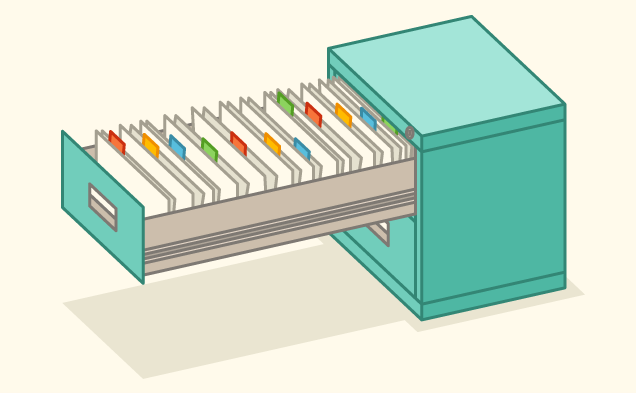
Beyond the Rental Applications:
Finance docs you’ll need
The truth about most real estate markets is that perfect rentals don’t last long. If you don’t act fast, it might be gone tomorrow. Johanna found their new apartment on Craisglist after only six days of searching.
“We were expecting to be stressed out for three weeks,” she says. “I saw a listing that didn’t look so great but I had a feeling that the pictures were old and it ended up being great for what we were looking for.”
Johanna was somewhat surprised when the building’s landlord began asking for lots of documentation about the couple’s finances – even though the building isn’t particularly fancy, she says, and doesn’t have a doorman. Luckily, she’d come across a blog post before their search that explained all of the financials renters might need beyond just filling out the rental application.
“The list was very extensive, so I thought it was for when you wanted to buy a co-op or something like that. But I made sure to have the parts that took longer to get. When the landlord started asking us for so much more stuff, it wasn’t that hard to get the rest of the documents.
“The process was pretty intense. He checked each of our credit scores, bank statements, pay stubs, he called our previous landlords.”
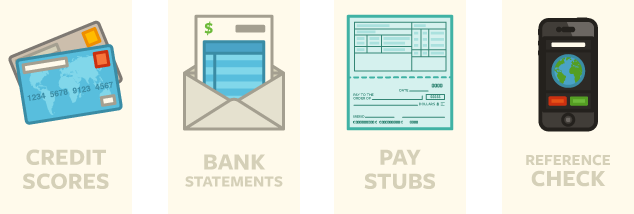
Getting your financial ducks in a row is like getting pre-approved for a mortgage before you go house hunting. You’ll be more likely to snag that perfect place if all you have to do is fill out the application and hand over any financial details right there on the spot. Keep in mind that documents will be required of everyone on the lease.
Get ready to snag the perfect rental with this financial docs checklist:
- Letter of employment – on company letterhead with your salary and start date.
- Pay stubs
- Letter of reference from your previous landlord(s). If this is your first rental, provide names and phone numbers of personal and/or professional references who can vouch for you.
- Bank statements
- Tax return(s) from the last two years – especially if you work for yourself
SOURCE: Curbed University
http://ny.curbed.com/archives/2012/03/29/scoping_out_a_rental_hood_and_getting_ready_to_sign_a_lease.php#.UNtXUyhzvJA.email
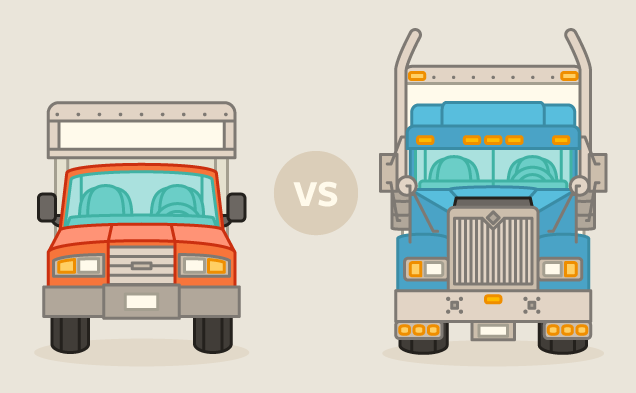
The Move: DIY or Hire Movers?
Finally, you’ll need to decide if you’re moving yourself or hiring professionals. For some people, this is an easy one – they’ve moved many times and have a system down. They know what friends to call, where you get a truck, and where to find free boxes. While that might work okay for local moves, it may not be the best solution for more complicated or long distance moves.
If one of you has always moved yourself but the other usually hires movers, you’ll need to decide which way to go based on how far and how complicated the move will be, how much stuff you’re moving, whether you’re moving in the ‘burbs with access to a driveway and wide streets or in the city with loading and unloading time restrictions and narrow streets. Also keep in mind that large, fragile items such as a glass table top may need special packing materials and expert handling to ensure it arrives in one piece.
For Tim, 28, and his girlfriend, a do-it-yourself approach wasn’t an option for their move. Tim’s girlfriend was living in Manhattan while he was in Washington, DC and they needed to get all of their things in the same truck and delivered to their new Chicago apartment the cheapest way possible.
“We didn’t want to split the move up and hire two sets of movers. That would not have been cost effective and the timing wouldn’t have worked out either,” says Tim.
He’d done local moves by himself before, but he and his girlfriend were totally out of their element with this type of move. When he called around to moving companies to get quotes, they would want had to send an estimator out to each home to generate the quote, which was a problem since the apartments were in different cities. What’s more, the concept of picking up his girlfriend’s things in Manhattan and then driving down to DC to pick up his things seemed totally foreign.
“Every time I mentioned it to moving companies they saw dollar signs. They thought, ‘We can charge this guy an arm and a leg to do this multi-stop move.’ It was daunting. I didn’t have a baseline for how much it would cost or how long it would take.”
Tim heard about Moveline through a friend and decided to ask for a quote. He says their move captain, Brittany, completed two quick video chats and built an accurate inventory of each apartment. She then gathered quotes from movers and coordinated the entire move. To complicate matters, the move happened just as Hurricane Sandy was about to slam into the east coast. Despite that, the move still went forward and everything happened right on schedule.
“When the moving company showed up in Manhattan and DC, there were no surprises,” says Tim. “Moveline did all the legwork for us. The service itself was fantastic. We were able to accomplish a challenging move with ease and that fit with our cost and timeline requirements in a way that no one else was able to accommodate.”
Anna used Pods to move from New York City to Madison the year before Aaron arrived. When it was time for Aaron to move, he dreaded the thought of hiring movers again.
“In previous moves, I’ve had nervous breakdowns. They were very traumatic, expensive and unpredictable,” he says. “I didn’t really know if I was dealing with a reputable company or even if they would show up. Often times they would quote me their price and then show up and change the price saying things like they didn’t realize I lived on the fifth floor or whatever. I’d have to haggle to get the price back down to what we initially agreed upon.”
This time Aaron decided to use Moveline, an experience he says that was so much better than his past moves. “This was the first move I’ve done where I didn’t get hives.” The full-service move included all loading and unloading. Aaron was responsible for packing his things into boxes, which the movers tagged with a special barcode stickers. When the truck arrived in Madison, movers scanned each barcode to ensure everything had arrived.

To Anna’s surprise, the price Aaron was quoted for his move ended up being only one third of the price she paid to use Pods — and her cost didn’t include loading and unloading. “I was totally floored. I couldn’t believe that you could move across the country for that price. And he was much more supported in the process.”
Sara says that even if you’re doing a local move, hiring movers is money well spent. When she lost her job and needed to vacate her studio, she tried to save money by doing the move by herself, but ended up getting hurt and exhausted in the process.
“Movers are fast and efficient. They can get it all done in a few hours when it would take me eight or nine to muscle a couch up stairs and through the door. When I lost my job and had to move myself, I got really sick because I exhausted myself. I wasn’t physically equipped to haul couches up stairs. Watching these guys work, they wrap everything – it’s a whirlwind watching them.”
From choosing the perfect place and blending your stuff and lives in one space to deciding on money matters, snagging a rental and actually relocating your stuff, there’s a lot to think about and plan for when you decide to move in together. While it does take a fair amount of planning, coordination, stress and money – once it’s over you get to relax knowing that you’ll be spending everyday with your best friend. You’ve already found your perfect match. With careful planning and using services like Moveline that can handle almost every aspect of your move, you can make sure your happy new home stays that way.
